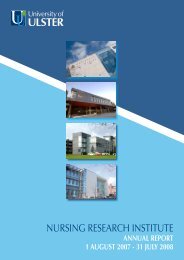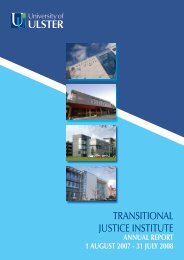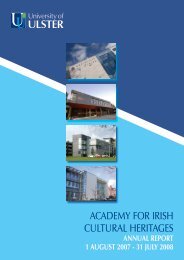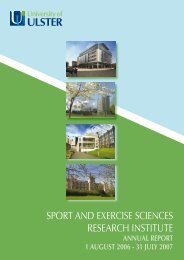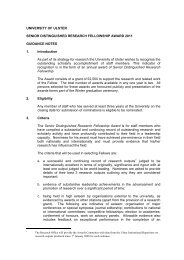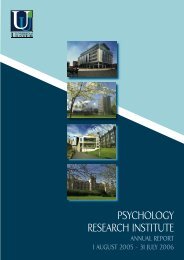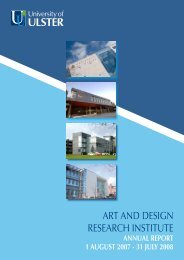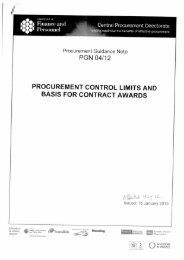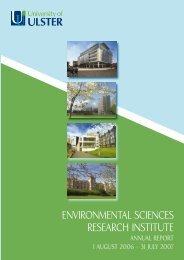biomedical sciences research institute - Research - University of Ulster
biomedical sciences research institute - Research - University of Ulster
biomedical sciences research institute - Research - University of Ulster
- No tags were found...
You also want an ePaper? Increase the reach of your titles
YUMPU automatically turns print PDFs into web optimized ePapers that Google loves.
Recent Funding Initiatives:C-TRIC: Academia-Business-Clinical <strong>Research</strong> Facility–Altnagelvin Hospital Site (partnership between the WesternHealth and Social Care Trust in partnership, the <strong>University</strong> <strong>of</strong> <strong>Ulster</strong> and Derry City Council) - £1.764 M (£1.3 MINI Intereg IIIa Programme; £464,000 ILEX Integrated Development Fund-IDF).INI Pro<strong>of</strong> <strong>of</strong> Concept Grant), Personalized Medicine in Breast Cancer: Predicting metastases-free survival in lymphnodenegative breast cancer patients £,79,0002008 (HSC R&D Office Cancer RRG <strong>Research</strong> Cohesion Grant) Role <strong>of</strong> IFITM1 in Breast Cancer, £5000Students graduated 2008:Natalie Scott (PhD): The Role <strong>of</strong> MicroRNAs in Breast Cancer Invasion.Seona McErlean (PhD): Genetic pr<strong>of</strong>iling <strong>of</strong> breast cancer.Crispin Madavo (PhD): Isolation and characterisation <strong>of</strong> VIP from tape-wormsRecent Publications:Thompson AH, Bjourson AJ, Orr DF, Shaw C, McClean S; Amphibian skin secretomics: application <strong>of</strong> parallelquadrupole time-<strong>of</strong>-flight mass spectrometry and peptide precursor cDNA cloning to rapidly characterize the skinsecretory peptidome <strong>of</strong> Phyllomedusa hypochondrialis azurea: discovery <strong>of</strong> a novel peptide family, the hyposins;Journal <strong>of</strong> Proteome <strong>Research</strong>, 6: 3604-3613, 2007Thompson AH, Bjourson AJ, Orr DF, Shaw C, McClean S; A combined mass spectrometric and cDNA sequencingapproach to the isolation and characterization <strong>of</strong> novel antimicrobial peptides from the skin secretions <strong>of</strong>Phyllomedusa hypochondrialis azurea; Peptides, 28: 1331-1343, 2007Membership <strong>of</strong> External Committees:Member <strong>of</strong> Bio-Business Northern Ireland. DETI Northern Ireland Academia-Industry Life & Health Sciences PanelGeneLibrary Ireland (Irish BioBank project) Steering Committee Member 2008-present.GeneLibrary Ireland (Irish BioBank project) Work-Package Chair 2008-present.Member Northern Ireland Science Industry Panel-MATRIX – Life and Health Sciences Horizon Panel.–2007-currentCouncil Member <strong>of</strong> Irish Society for Human Genetics 2006-presentMember <strong>of</strong> HPSS R&D Clinical Doctorate Review Panel (2004-2008).Dr Paul ThompsonLecturer in Molecular BiologyContact details:T: +44 (0)28 70323246p.thompson@ulster.ac.ukDr Thompson is primarily interested in the biological activities <strong>of</strong> the nuclear vitamin D receptor (VDR) and themechanisms through which it mediates the wide range <strong>of</strong> physiological responses to its cognate Vitamin D ligand.The <strong>research</strong> projects in Dr Thompson’s laboratory are broadly divided into two main areas <strong>of</strong> focus:Novel biological actions <strong>of</strong> VDR as a chemoprotective agent in epithelial-derived tissues:Dr Thompson and others have demonstrated that vitamin D can dictate expression <strong>of</strong> the CYP3A4 gene in coloncarcinoma cells, a pivotal factor for the metabolism and clearance <strong>of</strong> many potentially harmful xeno and endobioticcompounds. In expanding upon this concept our more recent data reveal that vitamin D can also regulate the levels <strong>of</strong>drug transporter proteins within the apical membrane <strong>of</strong> enteric cells. Taken in combination, our findings suggest that16



